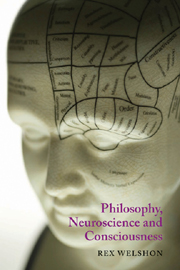Book contents
- Frontmatter
- Contents
- Preface
- Introduction
- PART I PHILOSOPHY AND CONSCIOUSNESS
- 1 Consciousness and conscious properties
- 2 Identity, supervenience, reduction and emergence
- 3 Reductive and non-reductive physicalisms
- 4 Representationalist theories of conscious properties
- PART II NEUROSCIENCE AND CONSCIOUSNESS
- PART III PHILOSOPHY, NEUROSCIENCE AND CONSCIOUSNESS
- Concluding semi-scientific postscript
- Appendix Functional neuroanatomy
- Notes
- Bibliography
- Index
2 - Identity, supervenience, reduction and emergence
from PART I - PHILOSOPHY AND CONSCIOUSNESS
- Frontmatter
- Contents
- Preface
- Introduction
- PART I PHILOSOPHY AND CONSCIOUSNESS
- 1 Consciousness and conscious properties
- 2 Identity, supervenience, reduction and emergence
- 3 Reductive and non-reductive physicalisms
- 4 Representationalist theories of conscious properties
- PART II NEUROSCIENCE AND CONSCIOUSNESS
- PART III PHILOSOPHY, NEUROSCIENCE AND CONSCIOUSNESS
- Concluding semi-scientific postscript
- Appendix Functional neuroanatomy
- Notes
- Bibliography
- Index
Summary
Since neither substance dualism nor idealism are viable, the only option left is some kind of physicalism, which claims that physical entities or parts thereof exhaust everything that is concrete, where a physical entity is an entity quantified over by physics (Hellman & Thompson 1975). Yet although every thing and every part of every thing is physical, disagreement whether every physical thing or part need have only physical properties remains. Those who claim that they must are reductive physicalists; those who think they need not are non-reductive physicalists. For reductive physicalists, conscious properties are reducible to some kind of physical, usually neural, property. For most non-reductive physicalists, conscious properties bear some other relation to physical properties that is weaker than identity but still substantial enough to warrant neuroscientific investigation. For other non-reductive physicalists, conscious properties do not bear any relation substantial enough to warrant neuroscientific investigation.
In this chapter, the ontologist's laboratory is opened, and the options for these relations between physical and other kinds of properties are examined. The ontological lab is an intangible place whose equipment is logic and concepts, a sterile environment largely uncluttered by specific considerations about conscious properties. Each of the relations – identity, reduction and non-reduction, supervenience and emergence – has a unique logico/ontological signature that remains invariant across applications. These signatures are the subject matter of this chapter. Some of the discussions are at a level of abstraction not typically encountered in neuroscience.
- Type
- Chapter
- Information
- Philosophy, Neuroscience and Consciousness , pp. 31 - 53Publisher: Acumen PublishingPrint publication year: 2010



